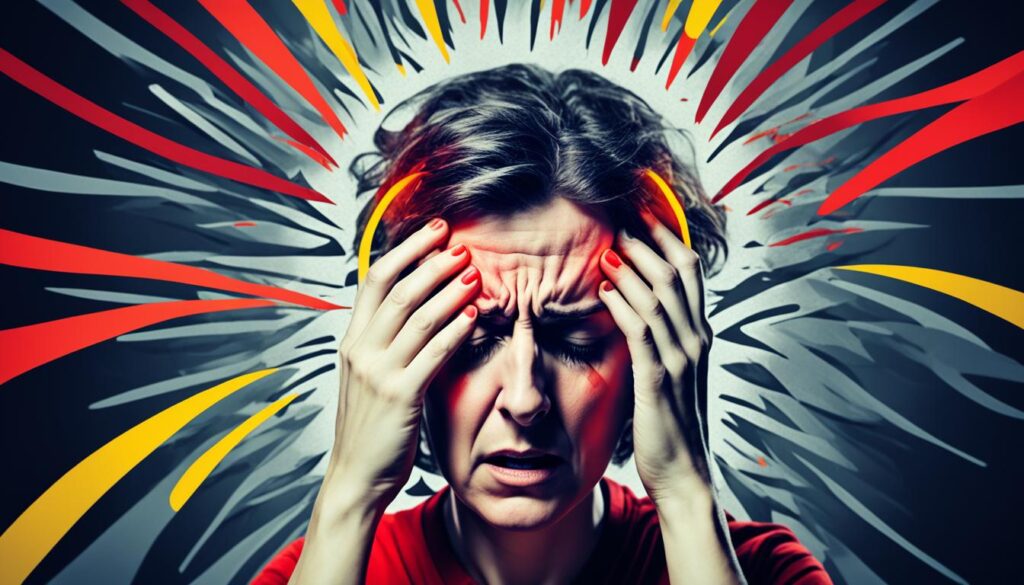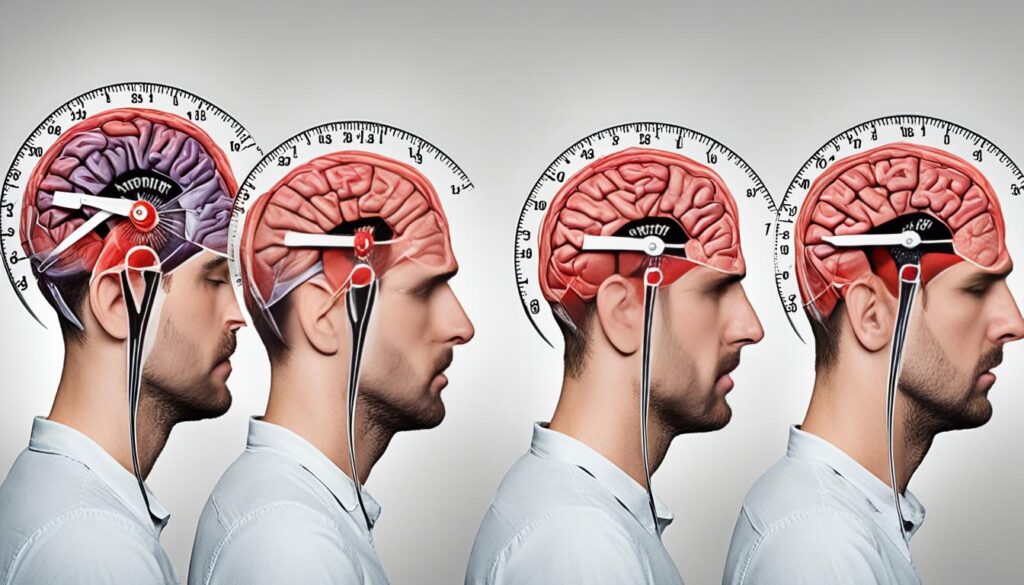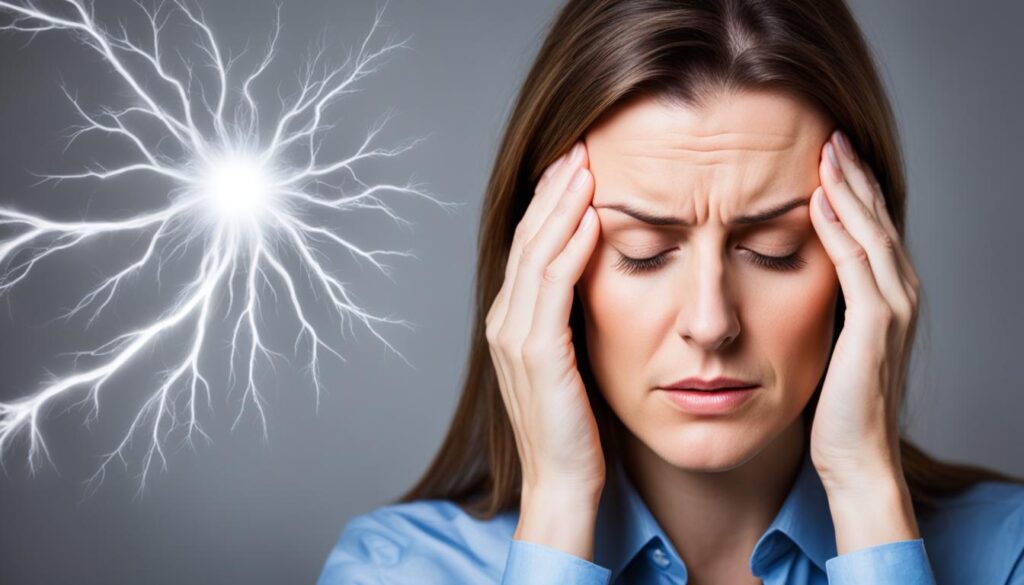Did you know that cluster headaches are so painful they’re often called “suicide headaches”?
This reflects how deeply disabling and unbearable the pain can be. Now, trigeminal nerve pain experience becomes even more intense.
A trigeminal nerve cluster headache is not your regular headache. It strikes suddenly, brings stabbing pain around one eye, and can happen multiple times a day. For those suffering, life can feel like a ticking time bomb of pain.
In this blog, we will walk you through everything you need to know about trigeminal nerve cluster headache, its causes, symptoms, diagnosis, treatment options, and how to find lasting relief.
Table of Contents
ToggleWhat is a Trigeminal Nerve Cluster Headache?
Let’s start by understanding the two core components of this condition: the trigeminal nerve and cluster headaches.
The trigeminal nerve is one of the 12 cranial nerves. It carries sensation from your face to your brain. This nerve also helps control muscles used in chewing. When this nerve is affected, pain can be intense and often focused around the eyes, cheeks, and forehead.
Cluster headaches are a type of headache disorder. They occur in cycles, with periods of frequent attacks (cluster periods) followed by remission. Each headache is short but extremely painful. Most attacks last 15 minutes to 3 hours and can happen up to 8 times a day.
During a trigeminal nerve cluster headache, the nerve gets activated abnormally, causing sharp, severe facial pain. Unlike trigeminal neuralgia, which causes electric-shock-like pain, this pain is deeper and more persistent. And unlike migraines, cluster headaches are not triggered by light or sound, and sufferers often can’t lie still.
Quick Stats
- Only 0.1% of the population suffers from cluster headaches (source: NIH).
- Males are 4 times more likely to suffer from them than females.
Causes and Triggers of Trigeminal Nerve Cluster Headaches
Let’s look at what causes a trigeminal nerve cluster headache and what things can trigger it. These headaches don’t just appear randomly. There’s a pattern and science behind them.
The Role of the Hypothalamus and Circadian Rhythms
Scientists believe the hypothalamus, the part of your brain that controls your biological clock, plays a major role.
- The hypothalamus controls body rhythms like sleep-wake cycles.
- Cluster headaches often strike at the same time each day or night.
- Changes in the hypothalamus can activate the trigeminal nerve, leading to severe pain.
This may explain why some people get attacks like clockwork — even waking up from deep sleep due to pain.
Common Triggers
While not everyone has the same triggers, there are some common ones:
- Alcohol: Just one drink can bring on an attack during a cluster period.
- Strong smells: Paint, perfumes, gasoline fumes.
- Bright or flickering lights.
- High altitudes or air travel.
- Sleep disturbances or oversleeping.
- Emotional stress.
These triggers don’t usually cause pain during remission periods, only during an active cluster phase.
Is There a Genetic Connection?
Yes, some people may inherit a risk. Studies show:
- People with a first-degree relative who has cluster headaches are at a higher risk.
- Genetics alone don’t cause it, but they do increase vulnerability.

Symptoms of Trigeminal Nerve Cluster Headache
The symptoms are usually easy to recognize once you know what to look for. The pain is very specific.
Sudden, Intense Pain on One Side of the Head
The most common sign of a trigeminal nerve cluster headache is severe pain that comes on quickly.
- Pain is usually around or behind one eye.
- Can spread to temple, forehead, nose, and cheek areas served by the trigeminal nerve.
- Each attack lasts 15 minutes to 3 hours.
- It can occur up to 8 times a day, often at night.
This is not a dull or throbbing pain. It’s sharp, burning, or stabbing.
Other Associated Symptoms
Along with the main pain, other signs include:
- Watery eyes on the side of pain.
- Stuffy or runny nose.
- Redness in the eye.
- Eyelid drooping or swelling.
- Restlessness: patients often pace or rock, unlike migraine sufferers who lie still.
For a more detailed understanding of cluster headache symptoms, refer to the table below:
| Symptom | Presence |
|---|---|
| Unilateral head pain | ✓ |
| Watery eye | ✓ |
| Eye redness | ✓ |
| Droopy eyelid | ✓ |
| Runny or stuffy nostril | ✓ |
| Flushing or sweating | ✓ |
Warning Signs and Duration
When it comes to cluster headaches, there are warning signs you can watch out for. Before the onset of a cluster headache, you may experience slight discomfort or a burning feeling on one side of the head. However, it’s important to note that cluster headaches often come on suddenly and do not leave much time to prepare.
The duration of a cluster headache attack can vary, but typically it lasts for about 30 minutes. However, it’s important to keep in mind that cluster headaches can also last for several hours. In some cases, individuals may even experience multiple attacks within a 24-hour period.
Cluster headaches typically occur in cycles. These cycles can last for weeks or even months, with individuals experiencing daily or near-daily attacks during this time. After the cycle ends, there is often a period of remission that can last for months or even years before the cluster headaches return.
To summarize, the warning signs of a cluster headache include slight discomfort or burning sensation on one side of the head, while the duration can vary from 30 minutes to several hours. These headaches often occur in cycles, with periods of remission in between.

Diagnosing Trigeminal Nerve Cluster Headache
Diagnosis starts with clinical signs but also involves ruling out other conditions.
Clinical Evaluation
Doctors rely on:
- Detailed headache history.
- Headache diary: time, duration, symptoms, triggers.
- Symptom pattern: One-sided pain, timing, associated eye/nose symptoms.
Doctors will also look to rule out:
- Trigeminal neuralgia vs cluster headache differences.
- Migraine or sinus headaches.
Imaging and Tests
To be thorough, your doctor may order:
- MRI or CT scan: These help rule out tumors, sinus issues, or brain bleeds.
- Neurological exams: Checking nerve function, reflexes, and responses.

Risk Factors
When it comes to cluster headaches, certain risk factors can increase the likelihood of experiencing these debilitating headaches. Understanding these risk factors can help individuals preemptively manage their triggers and seek appropriate treatment.
One prominent risk factor for cluster headaches is age. Typically, individuals between the ages of 20 and 40 are more susceptible to developing cluster headaches. This age range seems to be a common period for the onset of these headaches.
Frequent alcohol consumption is another risk factor associated with cluster headaches. Research suggests that alcohol can trigger or worsen the intensity of cluster headache attacks. Monitoring alcohol consumption and recognizing the potential impact it may have on headaches can be crucial in managing symptoms.
Additionally, certain medications have been identified as potential risk factors for cluster headaches. While the precise mechanism behind this association remains unclear, individuals taking specific medications may be more prone to experiencing cluster headaches. Consulting with a healthcare professional regarding medications and their potential side effects can aid in managing cluster headache risks.
Tobacco use is also considered a significant risk factor for cluster headaches. Smokers or individuals who frequently use tobacco products, such as cigarettes, cigars, or chewing tobacco, may be more susceptible to these intense headaches. Quitting tobacco use or reducing exposure to smoke can help alleviate cluster headache symptoms.
Gender is another interesting risk factor for cluster headaches. Studies indicate that men are more likely to experience cluster headaches than women. While the reason behind this gender difference is not fully understood, it emphasizes the importance of identifying potential risk factors on an individual basis.
Furthermore, a genetic component has been observed in some cases of cluster headaches. Up to 5% of cluster headache cases have a familial link, suggesting that a family history of cluster headaches can increase an individual’s susceptibility to this condition.
By being aware of these risk factors, individuals can take proactive steps to manage their cluster headache triggers, seek timely medical assistance, and implement effective prevention strategies.
Complications
Cluster headaches can have significant complications that impact various aspects of a person’s life. The severity of the pain and the frequency of attacks can interfere with daily activities, work responsibilities, and social engagements. Living with the constant fear of an impending headache can lead to feelings of helplessness and frustration.
One of the most concerning complications associated with cluster headaches is the increased risk of depression. The chronic nature of the condition, coupled with the intense pain, can contribute to a sense of hopelessness and despair. It is crucial for individuals experiencing cluster headaches to seek support from healthcare providers, who can provide appropriate treatment and mental health support.
In some cases, cluster headaches have been associated with suicidal thoughts. The intensity and relentless nature of the pain can push individuals to their limits, leading to feelings of desperation. If you or someone you know is experiencing severe headaches or having thoughts of self-harm, it is crucial to reach out to healthcare professionals immediately for assistance.
Cluster headaches can have a profound impact on a person’s quality of life. Understanding the complications associated with this condition and seeking appropriate medical care is essential for managing symptoms and improving overall well-being.
Similar Headaches
Cluster headaches are a type of primary headache that falls under the category of trigeminal autonomic cephalgias (TACs). However, there are other primary headaches within the TAC group that exhibit similar symptoms to cluster headaches. These include paroxysmal hemicrania, SUNCT syndrome, and hemicrania continua.
Paroxysmal hemicrania, like cluster headaches, is characterized by severe, unilateral head pain that is often accompanied by autonomic symptoms such as eye tearing, nasal congestion, and facial sweating. The attacks are typically shorter in duration, lasting from a few minutes to an hour, and may occur multiple times throughout the day or night.
SUNCT syndrome (short-lasting unilateral neuralgiform headache attacks with conjunctival injection and tearing) is another primary headache that shares similarities with cluster headaches. It is characterized by short-lasting, repeated episodes of excruciating unilateral head pain, along with autonomic symptoms such as conjunctival injection and tearing.
Hemicrania continua is a primary headache that causes continuous, unilateral head pain, often with autonomic symptoms similar to cluster headaches. However, unlike cluster headaches, hemicrania continua does not have distinct episodic cycles and generally responds well to treatment with the medication indomethacin.
Comparison of Similar Primary Headaches
| Headache Type | Symptoms | Duration of Attacks | Treatment |
|---|---|---|---|
| Cluster Headaches | Unilateral head pain, eye tearing, nasal congestion, facial sweating | 30 minutes to several hours | Oxygen therapy, sumatriptan injections, verapamil |
| Paroxysmal Hemicrania | Severe, unilateral head pain, eye tearing, nasal congestion, facial sweating | Minutes to an hour | Indomethacin |
| SUNCT Syndrome | Severe, unilateral head pain, conjunctival injection, tearing | Seconds to minutes | Indomethacin, nerve blocks |
| Hemicrania Continua | Continuous, unilateral head pain, eye tearing, nasal congestion, facial sweating | Ongoing | Indomethacin |
Treatment Options
Managing cluster headaches involves a range of treatments designed to relieve acute pain and prevent future attacks. With the right combination of therapies, many individuals can significantly reduce the impact of these intense headaches.
For immediate relief during an attack, oxygen therapy and sumatriptan injections are widely used. Inhaling pure oxygen through a mask can shorten the duration of an episode, while sumatriptan works quickly by narrowing blood vessels in the brain to ease pain.
On the preventive side, verapamil—a calcium channel blocker—is often prescribed to reduce the frequency and intensity of attacks. Taken daily, it helps stabilize blood flow patterns associated with cluster headaches.
Behavioral strategies also play an important role. Techniques like deep breathing, progressive muscle relaxation, and stress-reduction therapies such as cognitive-behavioral therapy or biofeedback can complement medical treatments and help minimize triggers.
Emerging medications, including antiepileptics like divalproex and topiramate, are showing promise in lowering both the pain and occurrence of attacks by regulating brain activity.
Since every case is different, it’s crucial to work with a specialist to tailor the best approach. For expert guidance, consult a neurologist for cluster headache treatment to explore the most effective options for your condition.
Summary of Treatment Options for Cluster Headaches
| Treatment Options | Description |
|---|---|
| Oxygen Therapy | Inhaling pure oxygen through a mask to alleviate pain and reduce duration of the attack. |
| Sumatriptan Injections | Fast-acting medication to constrict blood vessels and provide quick relief. |
| Verapamil | Calcium channel blocker for long-term prevention and reduction of cluster headache attacks. |
| Behavioral Treatments | Relaxation therapy and stress management techniques to reduce stress and prevent or minimize headaches. |
| Newer Antiepileptic Drugs | Divalproex and topiramate to stabilize brain activity and reduce pain and frequency of cluster headaches. |
Cluster Headache Survey Results
Let’s take a closer look at the results of the recent US Cluster Headache Survey. This comprehensive survey sheds light on the experiences and challenges faced by individuals living with cluster headaches.
Delays in Diagnosis and Misdiagnosis
The survey revealed that many people with cluster headaches experience delays in receiving a correct diagnosis. In fact, sinusitis and migraine were the most common misdiagnoses reported. These delays can prolong suffering and hinder appropriate treatment.
Impact on Mental Health
A striking finding from the survey was that more than half of the respondents reported experiencing suicidal thoughts. The severe impact of cluster headaches on mental health highlights the urgent need for improved support and resources for those affected.
Timing and Triggers
The survey confirmed that most cluster headache attacks occur between the early evening and early morning hours. This nocturnal pattern can significantly disrupt sleep and quality of life. Common triggers identified by respondents included alcohol, weather changes, and certain smells.
Increasing Awareness and Support
These survey findings underscore the importance of raising awareness about cluster headaches and improving access to accurate diagnosis and effective treatment. By addressing the delays in diagnosis, providing mental health support, and better understanding triggers, we can enhance the lives of individuals battling this debilitating condition.
| Survey Findings | Percentage of Respondents |
|---|---|
| Delays in Diagnosis | 67% |
| Misdiagnoses (Sinusitis and Migraine) | 42% |
| Reported Suicidal Thoughts | 58% |
| Timing of Cluster Attack (Evening to Early Morning) | 78% |
| Common Triggers (Alcohol, Weather Changes, Smells) | 65% |
Trigeminal Neuralgia (TN) and Cluster Headaches
Trigeminal neuralgia (TN) and cluster headaches are distinct but related neurological conditions. TN is characterized by severe, shooting or electric shock-like facial pain, usually limited to one side of the face. The pain is brief but can be triggered by certain activities such as shaving or toothbrushing. Both TN and cluster headaches involve the trigeminal nerve pathway and may have abnormalities in the hypothalamus. Antiepileptic drugs, such as gabapentin and lamotrigine, can be effective in managing both conditions.
| Trigeminal Neuralgia (TN) | Cluster Headaches |
|---|---|
| Severe shooting or electric shock-like facial pain | Excruciating pain centered around the eye |
| Usually limited to one side of the face | Often unilateral head pain |
| Brief episodes triggered by certain activities | Attacks that can last for 30 minutes to several hours |
| Trigeminal nerve pathway involvement | Involvement of the trigeminal nerve pathway |
| Possible abnormalities in the hypothalamus | Possible abnormalities in the hypothalamus |
| Treatment with antiepileptic drugs like gabapentin and lamotrigine | Treatment with antiepileptic drugs like gabapentin and lamotrigine |
When to See a Neurologist?
Some headaches need medical attention. Here’s when you should book an appointment.
- You have a new headache pattern or pain different from usual.
- You notice neurological symptoms: vision changes, numbness, or confusion.
- Your regular treatments stop working.
- The pain is disrupting daily life.
A neurologist can help rule out other conditions and build a personalized plan.
Expert Advice from Dr. Chandril Chugh
Living with trigeminal nerve cluster headache is exhausting, not just physically but emotionally. But you’re not alone. With the right diagnosis and treatment, you can regain control over your life.
If you are experiencing cluster headaches, it is crucial to consult healthcare professionals for a proper diagnosis and effective management. Seeking timely medical intervention can help improve your quality of life and minimize the impact cluster headaches may have on your daily activities and overall well-being.
As a US-trained, board-certified neurologist, I’ve helped hundreds of patients reduce pain, prevent future attacks, and reclaim their routines. Don’t wait. Early intervention is key.
Book a consultation with me today to find the best approach tailored to your symptoms.
FAQ
What are the symptoms of cluster headaches?
The symptoms of cluster headaches include unilateral head pain, watery eye, eye redness, droopy eyelid, runny or stuffy nostril, flushing or sweating. The pain is usually intense and can be described as burning, sharp, or stabbing. Some people feel restless and unable to sit still during an attack. Cluster headaches often occur at the same time every day and may be more severe at night.
How long does a cluster headache attack last?
The duration of a cluster headache attack is typically 30 minutes, but it can last up to several hours. Some people experience multiple attacks within a 24-hour period. Cluster headaches usually occur in cycles that last for several weeks or months and then go into remission for months or years before returning.
What causes cluster headaches?
The exact cause of cluster headaches is unknown, but it is believed to be related to the release of certain chemicals near the trigeminal nerve and dysfunction in the hypothalamus. Triggers for cluster headaches vary from person to person but may include tobacco and alcohol use, bright lights, hot temperatures, nitrites in food, and certain medications. Changes in seasons and sunlight exposure may also trigger cluster headaches.
What are the risk factors for cluster headaches?
Risk factors for cluster headaches include being between the ages of 20 and 40, frequent alcohol consumption, certain medications, and tobacco use. Men are more likely to experience cluster headaches than women. There may also be a genetic component, with up to 5% of cases having a familial link.
What are the complications of cluster headaches?
Cluster headaches can interfere with daily activities, work, and social life. The severe pain and frequency of attacks can lead to feelings of helplessness and depression. In some cases, cluster headaches have been associated with suicidal thoughts. It is important to seek help from healthcare providers if experiencing severe headaches or suicidal thoughts.
What are some similar headaches to cluster headaches?
Other primary headaches that resemble cluster headaches include paroxysmal hemicrania, SUNCT syndrome, and hemicrania continua. These headaches have similar symptoms but may differ in duration and response to specific treatments.
What are the treatment options for cluster headaches?
Treatment for cluster headaches focuses on relieving pain during attacks and implementing preventive strategies. Oxygen therapy and sumatriptan injections are often used for acute attacks. Verapamil is commonly prescribed for long-term prevention. Behavioral treatments, such as relaxation therapy and stress management, can be used alongside medication. Newer antiepileptic drugs, such as divalproex and topiramate, have shown promise in reducing pain and frequency of cluster headaches.
What are the results of the cluster headache survey?
Results from the US Cluster Headache Survey indicate that many people with cluster headaches experience delays in diagnosis, with sinusitis and migraine being common misdiagnoses. More than half of respondents reported experiencing suicidal thoughts. Most cluster headache attacks occur between early evening and early morning hours, with alcohol, weather changes, and smells being common triggers.
What is the relationship between trigeminal neuralgia and cluster headaches?
Trigeminal neuralgia (TN) and cluster headaches are distinct but related neurological conditions. TN is characterized by severe, shooting or electric shock-like facial pain, usually limited to one side of the face. The pain is brief but can be triggered by certain activities such as shaving or toothbrushing. Both TN and cluster headaches involve the trigeminal nerve pathway and may have abnormalities in the hypothalamus. Antiepileptic drugs, such as gabapentin and lamotrigine, can be effective in managing both conditions.
How can cluster headaches be managed and treated?
Cluster headaches are a debilitating condition characterized by severe pain centered around the eye. The exact cause is unknown, but it is believed to involve abnormalities in the trigeminal nerve pathway and hypothalamus. Treatment options include acute pain relief measures and preventive strategies. Behavioral treatments and newer antiepileptic drugs show promise in reducing pain and frequency of cluster headaches. It is important to seek help from healthcare providers for proper diagnosis and management of cluster headaches.
Source Links
About The Author

This article is medically reviewed by Dr. Chandril Chugh, Board-Certified Neurologist, providing expert insights and reliable health information.
Dr. Chandril Chugh is a U.S.-trained neurologist with over a decade of experience. Known for his compassionate care, he specializes in treating neurological conditions such as migraines, epilepsy, and Parkinson’s disease. Dr. Chugh is highly regarded for his patient-centered approach and dedication to providing personalized care.
→ Book a consultation to discover which remedies suit your needs best.




